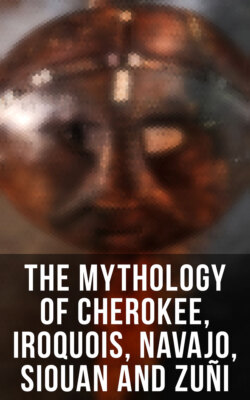Читать книгу The Mythology of Cherokee, Iroquois, Navajo, Siouan and Zuñi - James Mooney - Страница 55
На сайте Литреса книга снята с продажи.
Picture-Writing
ОглавлениеMost of the tribes of North America had evolved a rude system of picture-writing. This consisted, for the most part, of figures of natural objects connected by symbols having arbitrary or fixed meanings. Thus the system was both ideographic and pictographic; that is, it represented to some extent abstract ideas as well as concrete objects. These scripts possessed so many arbitrary characters, and again so many symbols which possessed different meanings under varying circumstances, that to interpret them is a task of the greatest complexity. They were usually employed in the compilation of the seasonal calendars, and sometimes the records of the tribe were preserved by their means.
Indian Picture Writing: A Petroglyph in Nebraska.
By permission of the Bureau of American Ethnology
Perhaps the best known specimen of Indian script is the Dakota 'Lone-dog Winter-count,' supposed to have been painted originally on a buffalo-robe. It is said to be a chronicle covering a period of seventy-one years from the beginning of the nineteenth century. Similar chronicles are the Wallum-Olum, which are painted records of the Leni-Lenâpé, an Algonquian people, and the calendar history of the Kiowa. The former consists of several series, one of which records the doings of the tribes down to the time of the arrival of the European colonists at the beginning of the seventeenth century. We append an extract from the Wallum-Olum as a specimen of genuine aboriginal composition. The translation is that made by the late Professor Brinton.
After the rushing waters had subsided, the Lenâpé of the Turtle were close together, in hollow houses, living together there.
It freezes where they abode: it snows where they abode: it storms where they abode: it is cold where they abode.
At this northern place, they speak favourably of mild, cool lands, with many deer and buffaloes.
As they journeyed, some being strong, some rich, they separated into house-builders and hunters:
The strongest, the most united, the purest were the hunters.
The hunters showed themselves at the north, at the east, at the south, at the west.
In that ancient country, in that northern country, in that Turtle country, the best of Lenâpé were the Turtle-men. [That is, probably, men of the Turtle totem.]
All the cabin fires of that land were disquieted, and all said to their priest: "Let us go."
To the Snake land, to the east, they went forth, going away, earnestly grieving.
Split asunder, weak, trembling, their land burned: they went, torn and broken, to the Snake Island.
Those from the north being free, without care, went forth from the land of snow, in different directions.
The fathers of the Bald Eagle and the White Wolf remain along the sea, rich in fish and strength.
Floating up the streams in their canoes, our fathers were rich, they were in the light, when they were at those islands.
Head Beaver and Big Bird said: "Let us go to Snake Island," they said.
All say they will go along to destroy all the land.
Those of the north agreed,
Those of the east agreed.
Over the water, the frozen sea,
They went to enjoy it.
On the wonderful slippery water,
On the stone-hard water all went,
On the great tidal sea, the muscle-bearing sea.
Ten thousand at night,
All in one night,
To the Snake Island, to the east, at night,
They walk and walk, all of them.
The men from the north, the east, the south:
The Eagle clan, the Beaver clan, the Wolf clan,
The best men, the rich men, the head men,
Those with wives, those with daughters, those with dogs.
They all come, they tarry at the land of the spruce-pines:
Those from the west come with hesitation,
Esteeming highly their old home at the Turtle land.
There was no rain, and no corn, so they moved farther seaward.
At the place of caves, in the Buffalo land, they at last had food, on a pleasant plain.
The Lenâpé come to the Place of Caves
